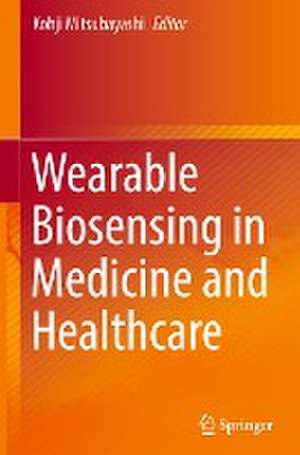Wearable Biosensing in Medicine and Healthcare
Editat de Kohji Mitsubayashien Limba Engleză Hardback – 5 ian 2024
This book is intended for graduate students, academic researchers, and professors that work in medical and healthcare research fields, as well as industry professionals involved in the development of wearable and flexible sensing devices and measurement systems for human bio/chemical sensing, medicalmonitoring, and healthcare services, and for medical professionals and government officials who are driving behavior change in health care.
Preț: 1019.97 lei
Preț vechi: 1243.87 lei
-18% Nou
Puncte Express: 1530
Preț estimativ în valută:
195.17€ • 204.32$ • 161.49£
195.17€ • 204.32$ • 161.49£
Carte disponibilă
Livrare economică 15-29 martie
Preluare comenzi: 021 569.72.76
Specificații
ISBN-13: 9789819981212
ISBN-10: 9819981212
Pagini: 489
Ilustrații: VIII, 489 p. 206 illus., 194 illus. in color.
Dimensiuni: 155 x 235 mm
Greutate: 1.02 kg
Ediția:1st ed. 2024
Editura: Springer Nature Singapore
Colecția Springer
Locul publicării:Singapore, Singapore
ISBN-10: 9819981212
Pagini: 489
Ilustrații: VIII, 489 p. 206 illus., 194 illus. in color.
Dimensiuni: 155 x 235 mm
Greutate: 1.02 kg
Ediția:1st ed. 2024
Editura: Springer Nature Singapore
Colecția Springer
Locul publicării:Singapore, Singapore
Cuprins
Part I: Wearable biomedical sensors.- Chapter 1. Cavitas biosensors (Body cavity sensors).- Chapter 2. Wearable sensors in the medical field.- Chapter 3. Wearable Electrochemical Biosensors for Glucose Monitoring.- Chapter 4. Smart textile hitoe and its application.- Chapter 5. Biosensors on Contact Lens.- Chapter 6. Wearable Device for Blood Pressure Estimation Based on Pulse Rate Measurement.- Chapter 7. Wearable non-invasive sensors for transdermal monitoring.- Part II: Novel approaches for wearable biosensing.- Chapter 8. Wearable microneedle sensors: Journey towards Lab under the Skin.- Chapter 9. Wireless biosensors for smart contact lenses.- Chapter 10. Wearable Biosensors on Sutures and Threads.- Chapter 11. Headphone type gas sensors for blood VOCs monitoring.- Chapter 12. Wearable Sensors for Non-invasive Health Monitoring.- Chapter 13. Wet interface technologies for the wearable organic-transistor-based sweat sensors.- Chapter 14. Wearable artificial pancreas devicetechnology.- Part III: Supporting technologies for wearable sensing.- Chapter 15. Design and fabrication of wearable biosensors: materials, methods and prospects.- Chapter 16. Printable Wearable Self-powered Biosensing System based on Paper-based Biofuel Cells using Porous Carbon Material.- Chapter 17. Energy Harvesting from Biting Force using Electret Sheet.- Chapter 18. Wearable core-body temperature sensor and its application.- Chapter 19. Wireless power transfer for biomedical applications and industrial deployment.- Chapter 20. Bio-fluorometric gas-imaging for wearable VOCs monitoring.- Chapter 21. Theranocloud, Smart Sensors for Point of Care Diagnostics test In Ophthalmology.
Notă biografică
Kohji Mitsubayashi received his Ph.D. from The University of Tokyo in 1994. Since 2003, he has been a professor at the Institute of Biomaterials and Bioengineering, Tokyo Medical and Dental University. His research interests include wearable biosensors, gas sensors for non-invasive bio-monitoring, and novel battery-free artificial organs (pancreas, muscles) with “Organic Engine (chemo-mechanical energy converter with biosensing technology).”
He has proposed a new device category “Cavitas sensors” in human body cavities for real-time bio-monitoring such as “Soft contact lens glucose sensors” (1995, 2008, 2009, and 2011), “Telemetric mouthguard sensors with a Bluetooth transmitter” (2016 and 2020), “Optic pharyngeal manometric sensor for deglutition analysis” (2007), etc. In 1988, he also started to develop several types of gas-phase biosensors (bio-sniffer, sniff-cam). They allow for real-time sensing and imaging of target volatiles in exhaled air, and skin gas (food and drink) with good sensitivity, gas-selectivity, and insensitivity to humidity.
He has proposed a new device category “Cavitas sensors” in human body cavities for real-time bio-monitoring such as “Soft contact lens glucose sensors” (1995, 2008, 2009, and 2011), “Telemetric mouthguard sensors with a Bluetooth transmitter” (2016 and 2020), “Optic pharyngeal manometric sensor for deglutition analysis” (2007), etc. In 1988, he also started to develop several types of gas-phase biosensors (bio-sniffer, sniff-cam). They allow for real-time sensing and imaging of target volatiles in exhaled air, and skin gas (food and drink) with good sensitivity, gas-selectivity, and insensitivity to humidity.
Textul de pe ultima copertă
This book contains chapters on wearable biomedical sensors and their assistive technologies for promoting behavioral change in medical and health care. Part I reviews several wearable biomedical sensors based on biocompatible materials and nano and micro-electromechanical systems (MEMS) technologies in the medical and dental fields. Part II introduces the latest approaches to wearable biosensing using unique devices for various skin targets such as sweat, interstitial fluid, and transcutaneous gases. Part III presents technologies supporting wearable sensors, including soft and flexible materials, manufacturing methods, skin volatile-marker imaging, and energy harvesting devices.
This book is intended for graduate students, academic researchers, and professors that work in medical and healthcare research fields, as well as industry professionals involved in the development of wearable and flexible sensing devices and measurement systems for human bio/chemical sensing, medical monitoring, and healthcare services, and for medical professionals and government officials who are driving behavior change in health care.
Caracteristici
Reviews wearable medical sensors with biocompatible materials and Nano & MEMS technologies Introduces latest in wearable biosensing for various skin targets Presents supporting technologies for wearable sensors
